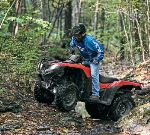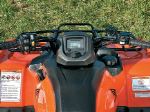

Honda can rightfully crow about the price point of its Rancher lineup. Base models have a starting MSRP of $5,199.

Honda's Rancher name is a bit misleading. The name “Rancher” implies all work. As we experienced firsthand, the Rancher ATV can get the work done and is a reliable workhorse, but there’s plenty of frisky fun in that new chassis as well.
While all that is probably obvious to the thousands of riders who have owned a Rancher in
years past, an argument could be made that the Rancher is equally at home on a trail in the woods.
The Rancher is that versatile. It can pull its own weight on the farm or ranch and also plays just as hard as it works—all in the same day.
While it’s been a season or two since Honda has made any serious changes to the Rancher, it
didn’t seem like it was necessarily in need of an overhaul. We asked Honda’s Eric Stevens, Principal Engineer –Rancher Large Project Leader, Since the Rancher had not received negative feedback from consumers, why all the changes?
“We would like to see more Ranchers on the trail,” he said, estimating Honda hopes the
ATV becomes a 50/50 work/recreation vehicle. “We view the Rancher as a do-it-all machine.
We wanted to keep all the great utility features and enhance the comfort.”
Redesigned, Refined, Fine-Tuned
Honda officials explained: “The previous-generation Rancher is very good for utility, but
we felt that we could make big improvements in the recreation area: specifically, items related
to handling and ride comfort.”
That meant changes had to be made. Redesigned, refined and fine-tuned for 2014, the
Rancher continues its tradition of reliability and reputation as an excellent value for the money.
Perhaps the biggest change for 2014 is the Rancher’s new double-cradle steel frame, which
gives the ATV increased stiffness (20 percent stiffer compared to previous Rancher models),
resulting in more precise handling, a feature riders will appreciate, especially when riding on
tight trails in the woods.
Is the “all-new” chassis really all-new?
According to Honda engineers, no parts in the 2014 Rancher’s frame come from the previous
Rancher.
One of the goals in designing a new chassis, say Honda engineers, is to provide a smoother
ride. Granted, farmers and ranchers might not be too concerned about a plush ride, but that’s
where Honda is appealing to off-roaders who want a nicer ride on the trail. One aspect of the
new chassis we think is important is not only does it have a high strength-to-weight ratio, but
the stronger frame doesn’t add any weight to the vehicle.
All-New Swingarm
Helping add strength and rigidity to the new chassis is an all-new swingarm with an enclosed rear axle. The design allows the swingarm rather than the rear final gear bearings to support rear-wheel loads, adding to the durability of the driveline. Instead of using bearings, the new swingarm features rubber bushings that help absorb input loads (read: improved comfort) at the junction of the swingarm and frame. Additionally, these rubber bushings are bonded to the inner and outer swingarm collars, preventing dirt from entering the swingarm pivot area.
Another upgrade aimed at pleasing trail riders (we’re not forgetting farmers and ranchers, but trail riders tend to be a bit more finicky) is a new suspension front and rear. The shocks have new damping characteristics and are preload adjustable and offer up 6.7 inches of travel both front and rear. That’s a bump in travel of .4 inches vs. the 2013 Rancher. Ground clearance has also been increased, from 6.5 inches to 7.2 inches. All those little increases have made a difference in the comfort and ride of the Rancher. We experienced that increased comfort during our test ride last fall in Ohio as we rode over rocks, downed trees, roots and creek beds that littered the trails. We were impressed with the Rancher’s ability to soak up the bumps and other trail hazards. It really did offer a nice ride across the board on all the Ranchers (and there are a bunch, but more on that later) we test rode.
Along with the improved ride of the Rancher is the ATV’s impressive transmission, both in the options offered and the performance. Options include a manual-shift five-speed (foot-operated), Honda’s Electric Shift Program (ESP), an alternative to the manual gearbox that makes gear shifts as easy as pressing the upshift or downshift button located on the left handlebar and, for those who don’t want to worry about shifting at all, the fully automatic DCT or Dual Clutch Transmission. Both the ESP and DCT are pretty slick and surprisingly smooth.
The electric shift transmission uses an onboard Electronic Control Module (ECM) that monitors engine rpm, countershaft speed, shift drum angle and shift spindle angle to help control the speed of the electric shift motor’s gear and clutch engagement. ESP is not dependent on battery power, as it operates whenever the engine is running.
ESP, DCT Our Favs
We rode Ranchers with all three types of transmissions and found we really had the most fun with the ESP, especially in the conditions we experienced in Ohio. It’s so easy to shift with your left hand.
We did like the DCT-equipped Ranchers, too, and the DCT deserves a little more explanation. The DCT is a new generation DCT with new updated dual-zone shift logic for improved adaptation to all riding conditions based on rider and vehicle inputs. The new shift logic automatically adjusts shift points, reducing “gear hunting,” thus improving the efficiency of the transmission while providing increased response and reduced engine lugging. Honda explained that the key to the DCT design is a dual-clutch configuration coupled with a two-piece mainshaft. The first mainshaft has first, third and fifth gears all driven by the first clutch. The second mainshaft is sleeved over the first shaft. It carries second, fourth and reverse gears and it’s driven by the second clutch. This design allows two gears to be engaged at the same time, and each gear is pre-shifted before power is applied. Shifting is then accomplished by disengaging one clutch and engaging the other. The result of this design is extremely quick shifts for less driveline lurching between shifts, especially under load, which means the chassis attitude remains more consistent during gear changes.
Still another feature on the Rancher 4x4 models is TraxLok selectable 2WD/4WD capabilities that enable the rider to quickly shift between 2WD and 4WD. TraxLok incorporates a two-way mechanical roller clutch with a series of hardened-steel rollers that lock up in a mere six degrees of rotation for a smooth, virtually instantaneous response while either accelerating or decelerating on flat ground or an incline. The TraxLok system only engages when the speed differential between the front and rear wheels is less than 6 mph. Once engaged, the system remains engaged on downhills for true 4WD braking.
Lots Of Options
We’re not sure if you’re keeping track at home, but with all the transmission and 2WD/4WD options, there are several different Rancher models available. Of course, the offerings include Electric Power Steering on select models. Ranchers available in 2014 include: the two-wheel-drive FourTrax Rancher with manual gearbox or in ES configuration, the FourTrax Rancher 4x4 adds TraxLok 4WD capabilities; the FourTrax Rancher 4x4 ES adds ESP push-button shifting to that 4WD equation; and the Rancher 4x4 Automatic DCT features Honda’s Automatic Dual Clutch Transmission (DCT). Two models, the Rancher 4x4 and Rancher Automatic DCT, are offered with power steering.
On Ranchers with power steering, a new attachment layout using a threepoint mount for the EPS mechanism makes the entire unit more rigid in its placement, and that makes for even more precise steering. That was evident on the tight trails we rode in Ohio. There was no “slop” in the steering and steering response was spot-on. Jumping back and forth between the EPS-equipped models and non-EPS Ranchers once again showed us that we prefer power steering models, especially when 4WD is engaged. And Honda’s EPS doesn’t “over-steer” like you find on some models. We like it when we can “feel” the trail and Honda’s power steering allows that.
The OHV liquid-cooled, fuel-injected 420cc engine returns essentially the same. There is new mapping for the Programmed Fuel Injection (PGM-FI) system as well as a new oxygen sensor that helps improve power delivery and throttle response, while also improving emissions and fuel efficiency. The 420cc engine won’t set any land speed records—we hit the rev limiter at 49-50 mph—but it wasn’t designed to. There’s plenty of power for work and play. Another feature that is hard to miss is the new meter display—found on all models (excluding the manual-shift 2WD Rancher)—that features added functions such as electronic fuel gauge, clock, coolant temperature gauge and a “maintenance minder” system that tracks both hours of run time plus miles driven.
Even with all those new features and improvements, it’s almost as if Honda is most proud that the new Rancher was designed (in California and Ohio) and is being built in the United States (South Carolina). Even though the Rancher is American-made and competitively priced (starting at $5,199), Honda’s biggest challenge may be to get the ATV crowd to accept that the Rancher is no longer a work-only vehicle. Let us get the ball rolling by saying the Rancher is an exceptional all-around ATV that can provide equal portions of fun and work.